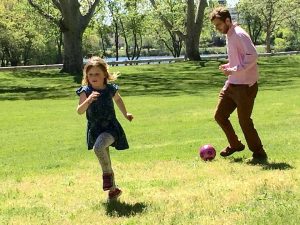
A streak of color flashed by me, composed of blond hair, red play clothes, navy Snoopy sneakers, and a shiny blue bike. But my attention quickly focused on the beaming 7-year old’s face. It seemed to say, “Learning to ride a two-wheeler opens a new world of movement and fun.” I might not have noted our daughter’s triumphant moment, except it was such a contrast to her expression and attitude a few years earlier when she tried cross-country skiing. Then, with her lower lip protruding, her eyes filled with tears, she stiffly planted herself on a New Hampshire hillside. Beautiful snowy day and all the encouragement in the world would not coax her into trying this new sport. She finally retreated to the lodge’s fireplace for the remainder of the day.
What is the best way to introduce a new sport to a child? Why do some sports come so naturally while others never seem to click? Does success hinge on talent or timing?
We asked ourselves this after Julie’s miserable morning on skis. Since my husband and I are fond of summer and winter sports, we naturally looked forward to many family swims, tennis doubles, bike hikes, and skiing touring. If these goals would be fulfilled, then we had to evaluate how we introduced each new sport or we didn’t ever get to first base. And in a broader sense, good skills and attitudes acquired from the home could enhance the athletic activities at school, camp, and play. Some basic principles have evolved as we continue to share new sports and improve familiar ones. Proper equipment and clothing, especially the initial preparation, should be investigated carefully. Whether you buy, borrow, or rent equipment, make sure it fits properly and is in good condition. What child or adult enjoys periodic adjustments or repairs on their equipment? It spells discouragement from the outset. We have found a local sports shop with expert advice as well as excellent equipment that we can depend upon. Also, it doesn’t seem overly expensive to buy quality equipment for children. When they do outgrow it, many stores offer trade-ins, it may be sold at school or garage sales, or become a “hand-me-down” to another child.
Clothing children properly is not difficult if you consider layers. Winter and wind proof clothing in winter and sweatshirts and hats in summer allow for comfort during temperature changes. Today, children’s fashions include items like down-filled vests and jogging suits which supply warmth but not bulkiness and can be easily removed as exercise warms them.
With each new sport, we decide who “coaches” – Dad takes baseball, Mom takes tennis – because it’s easier for children if just one parent gives directions. The other family members still participate, but in a backup role, retrieving balls, praising accomplishments, etc. After instruction comes practice with the amount needed varying with each child. You can demonstrate the back float a hundred times, but until children make it their own by thinking and practicing, hold off further swimming instructions. They know when mastery comes, making them ready to move forward. Patience, not pushing, motivates a child to keep trying.
Attitude could well be the most important factor in tackling a new sport. And it doesn’t matter how encouraging a parent’s attitude is, if they expect too much, too soon. Let’s invite children to help decide the goals – how long to practice, how far to hike. Let them set the pace by being the leader, instead of always the follower. It’s everyone’s attitude that counts in family sports and some rules help set a standard. For instance, a friend suggests: “Let’s never complain when we’re on the cross-country trail.” Sticking to this rule helped us ski home through a cold rain once without wails of discomfort, Julie included. She’ll be starting her third winter of skiing, and although it’s not her favorite sport, her attitude and skill has steadily improved. Perhaps she has learned a greater lesson: “Don’t give up!”